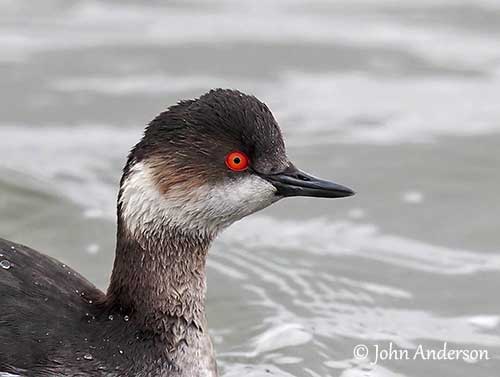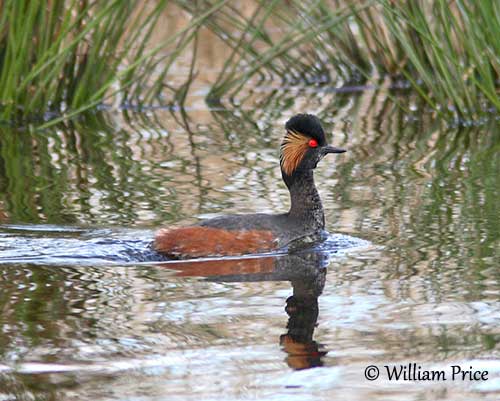
Fr: Grèbe à cou noir
Ang: Black-necked Grebe – Eared Grebe
All: Schwarzhalstaucher
Esp: Zampullín Cuellinegro
Ita: Svasso piccolo
Nd: Geoorde Fuut
Sd: svarthalsad dopping
Photographers:
John Anderson
John Anderson Photo Galleries
Didier Buysse
Vision d’Oiseaux
Jean Michel Fenerole
Photos d’Oiseaux du monde
Tom Grey
Tom Grey's Bird Pictures & Tom Grey's Bird Pictures 2
Otto Plantema
Trips around the world
William Price
PBase-tereksandpiper & Flickr William Price
Text by Nicole Bouglouan
Sources:
HANDBOOK OF THE BIRDS OF THE WORLD vol 1 by Josep del Hoyo-Andrew Elliot-Jordi Sargatal - Lynx Edicions - ISBN: 8487334105
THE COMPLETE BOOK OF BRITISH BIRDS – Written by “Royal Society for the Protection of Birds” experts - Préface de Magnus Magnusson - Michael Cady- Rob Hume Editors - ISBN: 0749509112
Bird Web (Seattle Audubon Society)
Bird Spot – Black-necked Grebe
Northern Ireland Priority Species
Biodiversity Explorer – The Web of Life in Southern Africa
What Bird-The ultimate Bird Guide (Mitchell Waite)
Wikipedia, the free encyclopaedia
Black-necked Grebe or Eared Grebe
Podiceps nigricollis
Podicipediformes Order – Podicipedidae Family
INTRODUCTION:
The Black-necked Grebe or Eared Grebe is one of the most abundant in the world. It breeds across a large range including Europe, Asia, Africa and both SW and W United States. Three subspecies share this wide range.
It breeds on lakes with vegetated areas, gravel pits, reservoirs and estuaries, but during winter, it is mainly seen in open bays and coastal areas. It feeds primarily on aquatic insects and small crustaceans by diving and swimming underwater. This species usually nests in more or less dense colonies, sometimes far from shore. The nest is typically a floating platform built by both adults. They are highly gregarious.
This grebe is known in America as the Eared Grebe, referring to the golden ear-tufts in breeding plumage.
The Black-necked Grebe or Eared Grebe is threatened by the reduction of its main food source, the pile worm, a marine annelid of the family Nereididae, caused by increase of salinity of the water that kills the worms and involves the death of grebes by starvation.
But currently, the species is not considered globally threatened.

DESCRIPTION OF THE BIRD:
Biometrics:
Length: 28-35 cm
Wingspan: 57-59 cm
Weight: 250-600 g (depending on the season).
The Black-necked Grebe or Eared Grebe in breeding plumage has black head, neck, breast and upperparts. Sides and flanks are chestnut whereas the belly is white. On the dark upperwing, the secondaries show a white patch well visible in flight.
The underwing is white with mostly dark tertials and pale grey-brown outer primaries. On the black head, the erectile crest feathers are black. The elongated feathers extending from the rear eye towards the sides of the nape are golden. The foreneck is often tinged brownish.
The black, thin bill may have slightly upturned lower mandible, but sometimes it is straight. The eyes are bright red. Legs and lobbed feet are dark greenish-grey.
Male and female are similar.
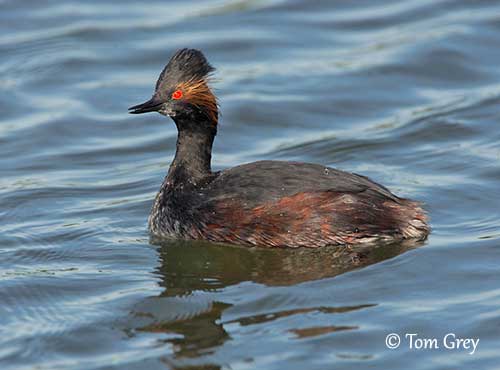
The non-breeding adult has blackish top of head, hindneck and mantle. The rump is white and often fluffy. Body sides, flanks and foreneck are greyish. The breast is mainly white, like both chin and throat.
The head appears rounder than in breeding plumage because the crest is shorter. A whitish area extends from the chin and below the eye area, upwards onto the nape. The bill is paler, mostly blue-grey.
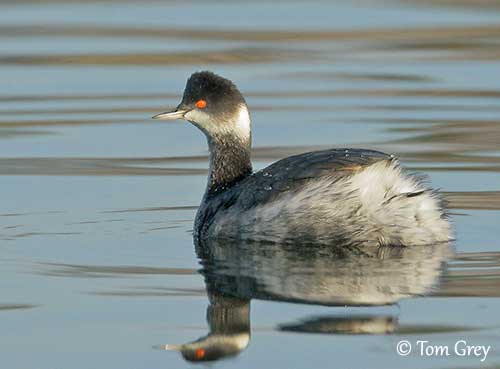
The juvenile resembles non-breeding adult with neck and back washed brownish. Head sides and upper neck are slightly tinged buffy to tawny. The eyes are much paler than in adults.
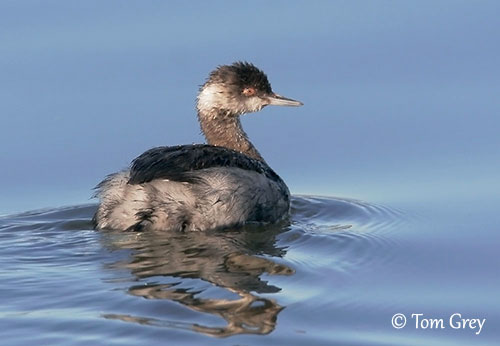
SUBSPECIES AND RANGE:
The Black-necked Grebe or Eared Grebe has three subspecies that may differ on plumage coloration and pattern (extent of white on the wing) and size.
P.n. nigricollis (described above) is found locally in Eurasia where it breeds across Europe, E to central Siberia and NE China, S to Pakistan. It winters S to S Europe, E through SW Asia to E China and Japan.
P.n. gurneyi is resident from Ethiopia, S through Tanzania to Namibia and South Africa. It is usually patchily distributed.
This race is paler and greyer overall, with paler ear-tufts and less rufous wing-coverts.
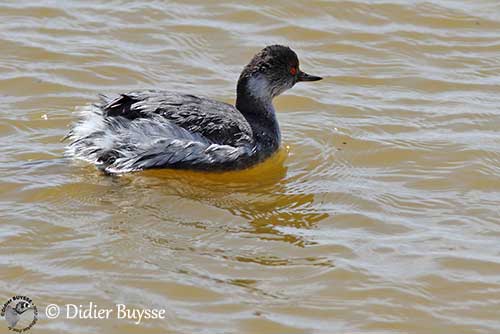
P.n. californicus breeds from SW Canada, through W USA to central Mexico. The northernmost populations migrate S to winter as far as Guatemala.
It has less white on secondaries, and the bill is larger than in nominate. In winter plumage, the lores appear paler than in “nigricollis”.
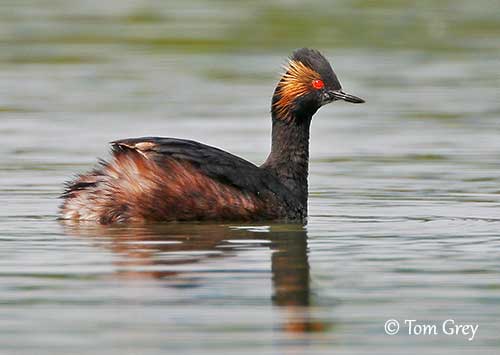
HABITAT:
The Black-necked Grebe or Eared Grebe breeds on lakes and large ponds with extensive vegetation and marshy borders, mainly reedbeds, and with stretches of open water. It may also occupy new or temporary habitats.
On migration and during winter, it moves to large freshwater or alkaline lakes, and also to coastal waters including bays, estuaries and channels.
This species is visible from sea-level to mountains, according to the range.
CALLS AND SONGS: SOUNDS BY XENO-CANTO
The Black-necked Grebe or Eared Grebe gives a repeated “poo-ee-chk” in bouts of 2-12 calls as advertising call. The female gives higher pitched shorter calls.
Both mates utter a soft whirring call when they are close to each other or when soliciting copulation. During the copulation, a trill is given in duet by both adults.
In aggression and defence behaviour, they give a harsh, rapidly repeated chattering, becoming a duet when both mates are together after being separated by disturbance. The alarm call is a single sharp “kowee” given by adults at irregular intervals.
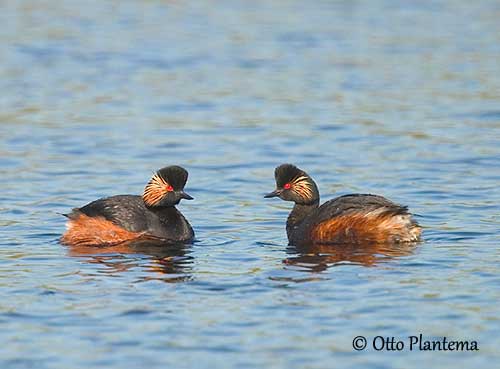
BEHAVIOUR IN THE WILD:
The Black-necked Grebe or Eared Grebe feeds primarily on aquatic insects and crustaceans. Insects include aquatic beetles, dragonfly larvae, flies and mayflies. But it also consumes small crustaceans, molluscs, tadpoles and occasionally some small fish.
On large alkaline lakes during migration, it feeds on brine shrimps, small crustaceans of the family Artemiidae.
Like other grebes, it eats sometimes some feathers to remove the remaining fish bones and other indigestible items.
The Black-necked Grebe or Eared Grebe catches its prey by diving and swimming underwater, thanks to the powerful lobbed feet. But numerous food items are also taken from water surface.
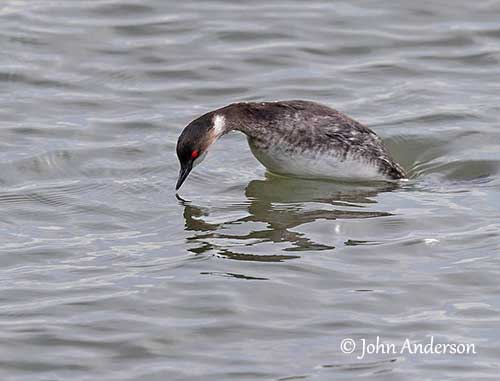
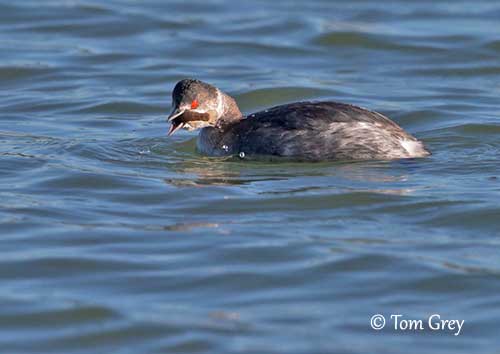
The breeding season involves complex courtship displays. Both mates are swimming side by side while turning their heads and giving loud calls. Other display shows the grebes facing each other and then, rearing up out of water and always moving their heads from side to side. The peak of the display occurs when the pair rears up again to vertical position before to rush across the water surface side by side.
The grebes may also present aquatic plants to potential mates.
Both mates often dive together and follow each other beneath water. The female is usually followed by the male, but reverse is not uncommon. They remain in close contact and call repeatedly is they are separated.
The copulation occurs on fairly solid substrate, usually a platform built for this use by the pair. During the early stages of the building, reverse mounting is very common. They are monogamous and both parents share the nesting duties.
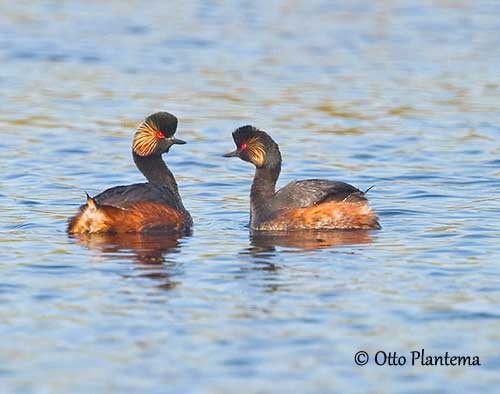
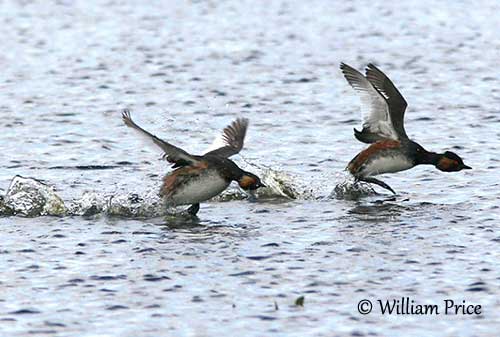
The Black-necked Grebe or Eared Grebe of the southern parts of the range is more or less sedentary, but these birds are mostly migratory and dispersive. They are very gregarious on migration and during winter, and huge concentrations can be formed at some sites in N America and Asia.
The main sites are Great Salt Lake, Utah, and Mono Lake, California, where the grebes are moulting. They can be seen at Salton Sea, California, in winter, and in S Caspian Sea.
They move mainly at night with some records of diurnal migrations in Palearctic. The flight starts at dusk and ends before dawn.
The flight of the Black-necked Grebe or Eared Grebe is direct with rapid wingbeats. Head and neck are stretched low and forwards, while the feet are trailing behind.
REPRODUCTION OF THIS SPECIES:
The breeding season occurs mainly in May-June in Europe, but it is longer in North America where the laying takes place between April and August. They breed in January-February in E Africa (Tanzania) and between October and April in South Africa.
The Black-necked Grebe or Eared Grebe is monogamous and usually semi-colonial with very variable colony size. Both adults build the nest in about a week, a floating platform made with algae, decaying vegetation and other soft plant matter. It is anchored to underwater plants in open, shallow water. The nest is defended by both adults.
The nest materials are collected near the site. The grebes dive near the nest and return to it with plant matter taken at the bottom. These materials are laid on top of the structure until forming a pyramid-shaped pile. The birds often add materials to the sides of the nest during the egg-laying and later too.
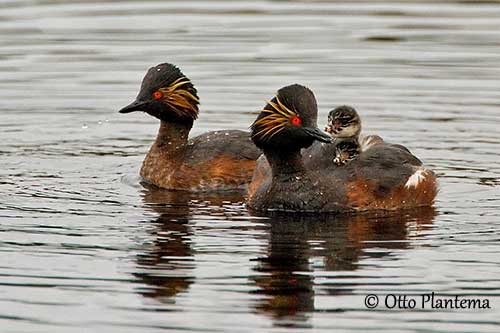
The female lays 3-5 whitish eggs, becoming brownish while the nesting cycle is progressing. Both adults incubate during about three weeks. The chicks leave the nest immediately after hatching, and both parents feed and tend them. Each adult may take a part of the brood, and they feed them mainly on insects and larvae.
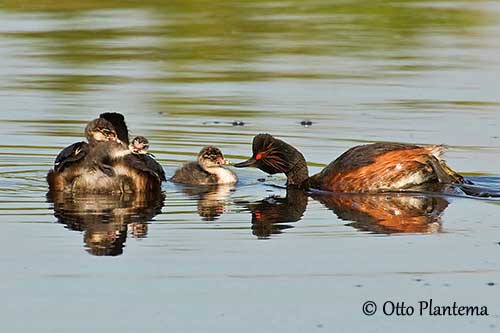
The chicks can be seen riding on adult’s backs when they are small. They have brownish-black down with pale stripes, and the underparts are white. They become independent about 21 days after hatching. The period of the first flight is poorly known.
The Black-necked Grebe or Eared Grebe produces a single brood per year, rarely two.
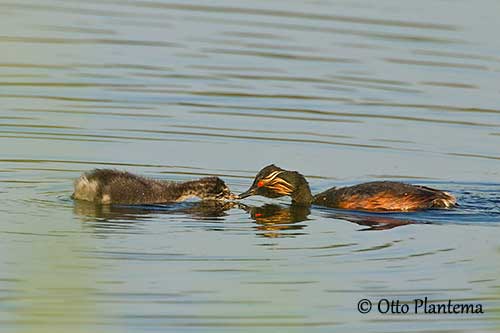
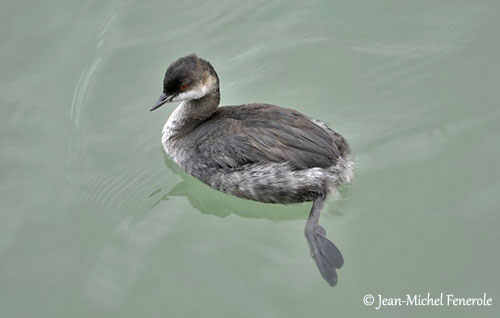
P.n. nigricollis
Juvenile
PROTECTION / THREATS / STATUS:
The Black-necked Grebe or Eared Grebe is described as widespread and locally abundant.
This species may suffer from reduction of food, especially pile worms in the Salton Sea in winter. This is due to the increase of salinity of the lake. The grebes become too weak to move elsewhere and die by starvation. El Niño may also involve crash of populations in winter habitats, due to reduction of food, following the warming sea-surface temperatures.
The global population is estimated to number 3,900,000/4,200,000 individuals (2015). The European population is estimated at 92,800/155,000 mature individuals (2015).
A small increase is reported in North America, but the overall population trend in uncertain.
However, the species is not globally threatened and the Black-necked Grebe or Eared Grebe is currently evaluated as Least Concern.
